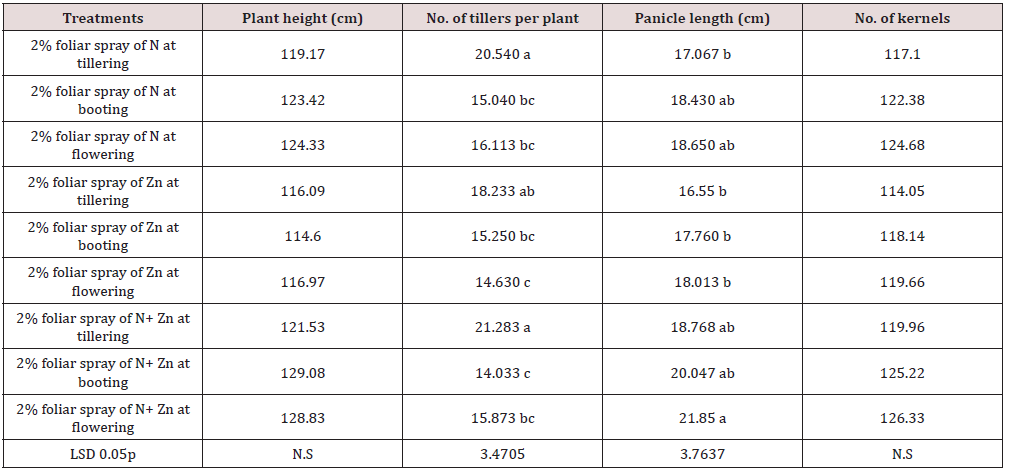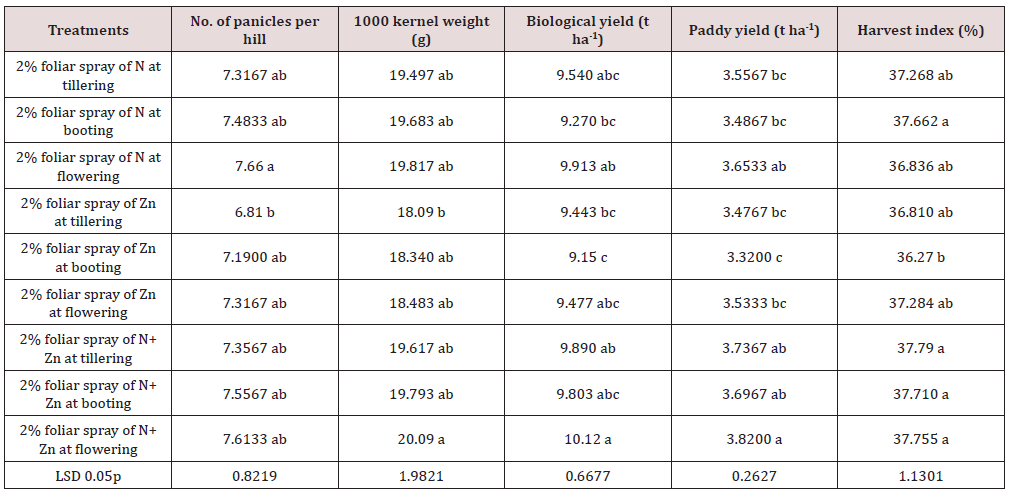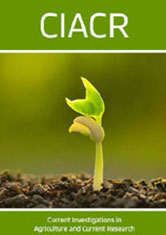Lupine Publishers | Current Investigations in Agriculture and Current Research
Abstract
Nutritious management in fine rice is primarily concomitant with the application of nitrogen and zinc fertilizers, which is challenging to amend under field conditions due to variations in soil fertility and environmental conditions. Therefore, a field experiment was carried out at Chakkanwali reclamation Research Station district Gujranwala to explore the role of nitrogen and zinc on the growth and yield of fine rice during kharif 2016. This study was laid out in a randomized complete block design with factorial arrangement having three repeats. Experimental treatments comprised of 2% foliar spray of nitrogen and zinc at tillering, booting, and flowering stage alone and in combinations. Results indicated that exogenous application of 2% nitrogen and zinc at flowering stage significantly improved all the yield contributing parameters which ultimately enhanced the final paddy yield.
Introduction
Rice is a delicious food for all the tiers of society in most of the states around the world. Billions of people eat rice for at least once a day to fulfill their dietary needs [1]. Increasing rice productivity in all domains is authoritative to meet the mounting demand of the world’s population. Rice grains are wonderful source of carbohydrates, fiber, fat, vitamins, minerals, energy and number of its by-products increases the value of rice crop across the biosphere [2-4]. Rice accounts for 3.1% in the value added in agriculture and 0.6 percent of GDP of Pakistan [5]. Rice cultivated area in Pakistan increased up to 6.4% as compared to last year during 2017-18. Its cultivation grasped historically maximum level of 7,442 thousand tones against the production of 6,849 thousand tones [5]. Average production in Pakistan is lower as compared to developed countries of the world. Among various factors causing turn down the rice productivity; imbalanced use of fertilizers is significant [6].
Optimum plant nourishment is one of the absolute imperative elements in enhancing the rice productivity. Among all the plant nutrients, nitrogen is critical for rice, and generally it is the most yield limiting nutrient in rice production domains around the globe [7]. As availability of organic nitrogen in soil is frequently minimizing by intensive cultivation of exhaustive crops, leaching, ammonia vitalization and de-nitrification. Rice plants required nitrogen during early growth phase to encourage tillering and vegetative growth, which in turn regulates the probable number of panicles. While application of nitrogen during reproductive phase improved the primary panicle formation and contributes to sink size in the late panicle formation period and play a vital role in grain filling, enhancing the photo-synthetic capacity and encouraging accumulation of carbohydrate in leaf sheaths and culms [8]. Among various micronutrients, zinc also play vital in optimum crop growth [9] and is prerequisite in small amount to allow several crucial plant physiological pathways to work properly [10]. It plays an important role in maintaining the integrity of biological membranes, the resistance to contagion by assured pests [11] and the pollination by affecting the formation of pollen tube [12,13]. It is also necessary in the carbonic enzymes that benevolences in all photosynthetic tissues and for chlorophyll biosynthesis [14,15].
However, its scarcity upsets numerous biochemical processes, such as auxin metabolism, enzyme activation, cytochrome and nucleotide synthesis, chlorophyll production, membrane integrity and growth [16]. Its insufficiency shows uneven plant growth, dusty brown spots on upper leaves of stunted plants, reduced tillering and enhanced spikelet sterility in rice Dobberman and Fairhurst, 2000. Application of nitrogen fertilizer directly to soil causes loss in the form of volatilization and leaching while in case of zinc fertilizers, the soluble portion leaches down. These losses can be minimized through the exogenous application of these nutrients which may confirm prompt accessibility of nutrients by the leaf tissues and effective movement to the developing parts of plant with minimum loss [17-21]. Keeping in mind these facts, the present study was designed to explore the role of exogenous application of nitrogen and zinc fertilizers at different stages of rice.
Materials and Methods
Experimental site and treatments
A field study was carried out at Chakkanwali Reclamation Research Station, District Gujranwala to explore the response of exogenous application of nitrogen and zinc on different growth stages of fine rice during Kharif 2016. The experiment was laid out in a randomized complete block design with factorial arrangement having three repeats. Experimental treatments comprised of 2% foliar spray of N and Zn at tillering, booting and flowering stage alone and in combinations.
Soil analysis
Prior to seedbed preparation, composite soil samples were collected from 0 to 30 cm depth for physico-chemical analysis. The soil of experimental site was silt loam, having pH 8.5, EC 2.11 dS m-1, organic matter 0.56%, total nitrogen, available phosphorus and exchangeable potassium 0.042%, 0.0062, 0.136 mg kg-1.
Crop husbandry
Twenty-eight days old nursery of fine rice (cv. Super Basmati) was transplanted in standing water on 11th July 2016 with 20 cm plant to plant and 22.5 cm row to row distance. Recommended dose of phosphorus (90 kg ha-1) and 1/3rd of nitrogen (50 kg ha-1) was applied at the time of transplantation. The remaining two-thirds of inorganic nitrogen (100 kg ha-1) were applied in two equal splits at tillering and panicle initiation stages. The water level in the field was maintained at 15 to 20 cm up to 30 days after transplanting and then water was drained out from the field for 2 days. After that water level was maintained at 10 to 15 cm until a week before final harvest. All other agronomic practices were kept uniform for all the experimental units to keep the crop free from pests. A unit area (1m2) was selected at random from two different sites for each plot. At maturity, grain yield, biological yield, harvest index, plant height, panicle length, number of kernels per panicle, number of tillers per plant and final plant height was measured.
Statistical analyses
The data for investigated treatments was analyzed by using the software Statistix 8.1, following Fisher’s analysis of variance and the least significant difference (LSD) test at 5% levels of probability was used to compare the means of different treatments [22].
Results and Discussion
Plant height (cm)
Plant height divulges the overall vegetative growth of rice in response to management practices. The results showed that the foliar application of nitrogen and zinc at different growth stages had non-significant effect on final plant height (Table 1). However exogenous application of 2% nitrogen and zinc at booting stage produced taller plants (129.08cm). While foliar spray of 2% zinc at booting produced minimum plant height (114.60cm) of rice.
No. of fertile tillers per plant
Tillering of a plant depends on the genotype, environment as well as the plant nutrition. Statistical analysis of the data showed significant effect of foliar spray of 2% nitrogen and zinc at different growth stages of rice (Table 1). Exogenous application of 2% N+ Zn at tillering stage produced significantly higher number of tillers per plant (21.28). Lower number of fertile tillers per plant (14.03) was observed with foliar spray of 2% N+ Zn at booting stage. Higher number of fertile tillers per plant might be due to the application of Zn that increased N use efficiency that ultimately produced more effective tillers per plant. Similar findings were reported by Islam [23] and Abdul and Balasubramanian [24]. Similarly, the studies carried out in IRRI [16] indicated that zinc application activates and increases tillering capacity in rice due to improved enzymatic activity.
Panicle length (cm)
Panicle length affects in grain yield by more transport of photosynthesis material. Panicle length varied significantly due to exogenous application of 2% nitrogen and zinc at different growth stages (Table 1). Foliar application of 2% N+ Zn at flowering stage produced significantly higher panicle length (21.85 cm). While foliar application of 2% Zn at tillering stage produced minimum panicle length (16.55 cm). Similar results were reported by Bandara [25] who showed that panicle length of rice was affected by nitrogen and zinc application. Similarly, Sarwar [26] also observed the low size of panicle length in without Zn application.
No. of kernels per panicle
Many factors affect the kernels per panicle such as genotype, cultural practices used (planting date, seeding rate and soil fertility) and growing conditions (air and soil temperature, etc.). Exogenous application of 2% nitrogen and zinc at different growth stages had no significant effect on number of kernels per panicle (Table 1). However, foliar spray of 2% N+ Zn at flowering stage produced higher number of kernels per panicle (126.33). While foliar application of 2% Zn at tillering stage lower number of kernels per panicle (114.05).
Table 1: Effect of exogenous application of nitrogen and zinc on the growth and yield contributing parameters.

No. of panicles per hill
Number of panicles per hill plays an imperative role in influencing the final grain yield. Genetic makeup, optimum crop management and availability of nutrients is greatly influenced the setting of panicles. Statistical analysis of the data showed significant effect of foliar spray of 2% nitrogen and zinc at different growth stages number of panicles per hill of rice (Table 2). Exogenous application of 2% nitrogen at flowering stage produced significantly higher number of panicles per hill (7.66). Lower number of panicles per hill (6.81) was observed with foliar spray of 2% zinc at tillering stage. It could be attributed to the improved availability and uptake of other nutrients resulting in improvement in metabolic activities.
Thousand kernel weight (g)
Thousand kernel weight varied significantly due to exogenous application of 2% nitrogen and zinc at different growth stages (Table 2). Exogenous application of 2% nitrogen and zinc at flowering stage produced significantly heaver kernel weight (20.09 g). While foliar spray of 2% zinc at tillering stage produced minimum kernel weight (18.09 g). It might be due to more efficient participation of all three micronutrients in various metabolic processes which enhanced accumulation of assimilates in the grains and resulted in heavier grains. Our results are supported by Suleimani [27] who recorded significantly increased kernel weight by integrating micronutrients like Zn, Fe, Mn and Cu.
Biological yield (t ha-1)
Vegetative and reproductive growth of rice crop indicated the biological yield and it displays an indirect index of photosynthetic machinery as it represents the total biomass assembles by the plant. Biological yield varied significantly due to exogenous application of 2% nitrogen and zinc at different growth stages (Table 2). Foliar spray of 2% nitrogen and zinc at flowering stage produced maximum biological yield (10.12 t ha-1). While application of 2% zinc at booting stage produced minimum biological yield (9.15 t ha- 1). Supreme biological yield was recorded may be owing to more plant height, fertile tillers per plant, number of kernels per panicle and thousand grain weight with efficient utilization of nutrients, sunlight interception and water, which ultimately produced more biomass and grains [28].
Paddy yield (t ha-1)
Paddy yield is composed of various yield components such as number of panicles, kernels per panicle and1000 kernel weight. Statistical analysis of the data showed significant effect of foliar spray of 2% nitrogen and zinc at different growth stages on paddy yield of rice (Table 2). Exogenous application of 2% nitrogen and zinc at flowering stage produced significantly higher paddy yield (3.82 t ha-1). Lower paddy yield (3.32 t ha-1) was observed with foliar spray of 2% zinc at booting stage. In this study, the use of nitrogen and zinc produced the highest paddy yield due to the combined effect of many yield components including higher number of tillers per plant, number of panicles per hill, number of kernels per panicle and 1000 kernel weight. Chaphale [29] recorded higher paddy yield when NPK was applied with zinc in combination. Previous findings also revealed that the application of zinc fertilizer not only increased yield but also zinc concentrations in rice seed [30-33].
Harvest index (%)
Harvest index indicated the photosynthesis efficiency of crop plants which converted into the economic yield. More harvest index showed the prolific efficiency of a crop. Harvest index varied significantly due to exogenous application of 2% nitrogen and zinc at different growth stages (Table 2). Maximum harvest index (37.79%) was recorded with the exogenous application of 2% nitrogen and zinc at tillering stage. Minimum harvest index (36.27%) was observed with foliar spray of zinc at booting stage. Higher harvest index indicated its superior ability of better dry matter partitioning towards grains [14].
Table 2: Effect of exogenous application of nitrogen and zinc on yield contributing and yield parameters of rice.

Read More Lupine Publishers Agriculture Journal Article:

No comments:
Post a Comment
Note: only a member of this blog may post a comment.